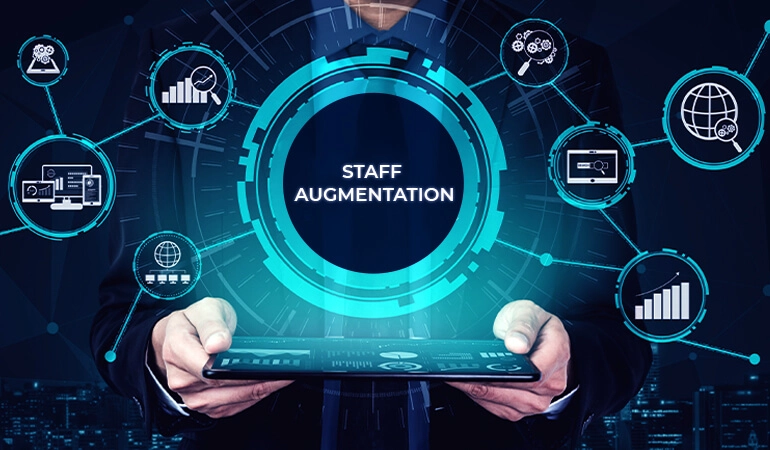Introduction
In today’s rapidly evolving business landscape, it is critical for organizations to stay ahead of the curve in terms of technology and talent. Two key strategies that companies are increasingly using to achieve this goal are Staff Augmentation and Talent Augmentation. While these two approaches have some similarities, they are distinct in their focus and impact. In this article, we will explore Talent Augmentation and how it complements Staff Augmentation to unlock the full potential of your workforce.
Staff Augmentation: A Brief Overview
Staff Augmentation is the process of hiring external resources to supplement your internal workforce. This can take many forms, such as hiring temporary or contract workers, partnering with third-party vendors or outsourcing providers, or leveraging staffing agencies to fill key roles. Staff Augmentation can be a valuable strategy for businesses that need to scale quickly, fill short-term gaps in their workforce, or access specialized skills and expertise.
Talent Augmentation: Enhancing Workforce Capabilities with Technology
Talent Augmentation, on the other hand, is focused on using technology to enhance the skills and capabilities of your existing workforce. This can involve a range of tools and techniques, such as artificial intelligence, machine learning, augmented reality, and virtual reality. Talent Augmentation is designed to help employees work smarter, faster, and more efficiently, and to enable them to take on new and more challenging roles within the organization.
Unlocking Employee Potential with Talent Augmentation
One of the key benefits of Talent Augmentation is that it can help organizations tap into the full potential of their workforce. Many employees have untapped skills and talents that may not be fully utilized in their current roles. By using technology to augment their capabilities, businesses can unlock new opportunities for growth and innovation. This can lead to greater job satisfaction and employee retention, as well as improved productivity and efficiency.
Addressing the Skills Gap with Talent Augmentation
Talent Augmentation can also help businesses address the skills gap that exists in many industries. As technology continues to advance at a rapid pace, many workers find themselves struggling to keep up with the latest trends and tools. Talent Augmentation can help bridge this gap by providing employees with access to training and development resources that help them stay up to date with the latest trends and techniques. This, in turn, can help businesses stay ahead of the curve and maintain a competitive edge in the market.
Improving the Bottom Line with Talent Augmentation
Another benefit of Talent Augmentation is that it can help businesses improve their bottom line. By using technology to automate routine tasks and streamline processes, businesses can reduce costs and improve efficiency. This can free up resources to invest in other areas of the business, such as research and development or marketing and sales. By leveraging Talent Augmentation to optimize their workforce, businesses can create a more agile and adaptable organization that can respond quickly to changing market conditions and customer needs.
Strategic Approaches to Talent Augmentation
However, to fully realize the benefits of Talent Augmentation, it is important for businesses to approach this strategy in a thoughtful and strategic manner. This requires a clear understanding of the needs and goals of the organization, as well as an assessment of the skills and capabilities of the existing workforce. It also requires a commitment to investing in the right tools and resources to support Talent Augmentation, such as training and development programs, data analytics tools, and cloud-based software platforms.
Balancing Talent Augmentation with Staff Augmentation
Another important consideration for businesses is the need to balance Talent Augmentation with Staff Augmentation. While Talent Augmentation can help businesses optimize their existing workforce, there are times when it may be necessary to bring in external resources to supplement the internal team. For example, if a business is facing a sudden surge in demand or a shortage of skilled workers in a particular area, Staff Augmentation may be the best option to quickly fill the gap and maintain operations.
Conclusion
In conclusion, Staff Augmentation is a powerful tool for businesses that want to unlock the full potential of their workforce. By using technology to enhance the skills and capabilities of their employees, businesses can create a more agile and adaptable organization that can respond quickly to changing market conditions and customer needs. However, it is important for businesses to approach Talent Augmentation in a thoughtful and strategic manner, and to balance this strategy with Staff Augmentation when necessary. By doing so, businesses can create a dynamic and flexible workforce that is well-equipped to thrive in today’s ever-changing business environment. Ultimately, the combination of Staff Augmentation and Talent Augmentation can help businesses achieve their goals and drive growth and innovation for years to come.




